(Last updated on 10/03/2025)
Mérida is often referred to as ‘Little Rome’ for a reason. Founded as Augusta Emerita in 25 BCE, it became the capital of the Iberian Roman province of Lusitania. The Roman origins are present today in its Archaeological Ensemble – one the Extremadura’s three UNESCO World Heritage Sites – boasting numerous and well-preserved remains.
In this article, aimed at first-time travellers with an interest in historical sights, I walk you through the main examples of Roman architecture in Mérida, so you don’t miss anything.
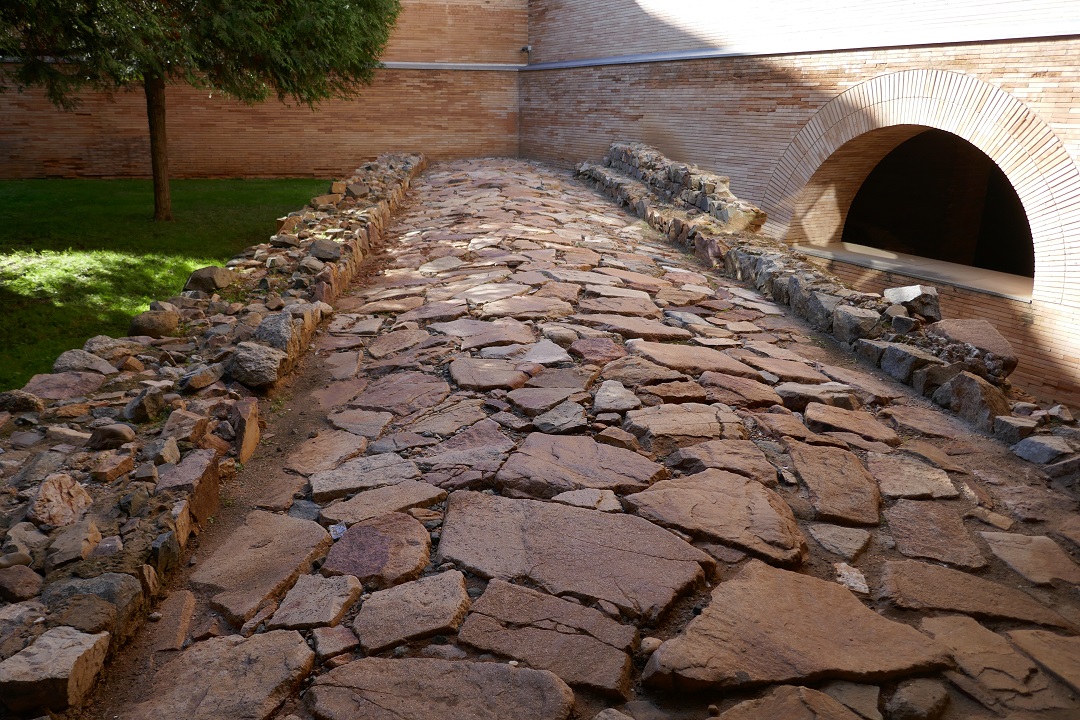
Table of contents
- 1 Teatro Romano
- 2 Anfiteatro Romano
- 3 Casa del Anfiteatro
- 4 Circo Romano
- 5 Casa del Mitreo and Columbarios funeral site
- 6 Templo de Diana
- 7 Puente Romano
- 8 Dique Romano
- 9 Museo Nacional de Arte Romano
- 10 Acueducto de San Lázaro-Rabo de Buey
- 11 Termas Romanas de San Lázaro
- 12 Acueducto de Los Milagros
- 13 Área arqueológica de Morería
- 14 Arco de Trajano
- 15 Termas Romanas de la Nieve
- 16 Pórtico del Foro Municipal de Augusto
- 17 Termas Romanas
- 18 Torre de Agua (Castellum Aquae)
- 19 Map of Mérida Roman architecture
Teatro Romano
Mérida’s Roman Theatre is Extremadura’s most visited sight, and rightly so. Built around 16-15 BCE, this dazzling construction could hold around 6,000 spectators at the time. Today, it seats around 3,000 people. Apart from a tourist attraction, it’s an active venue hosting the International Classical Theatre Festival and the Stone & Music Festival in summer.
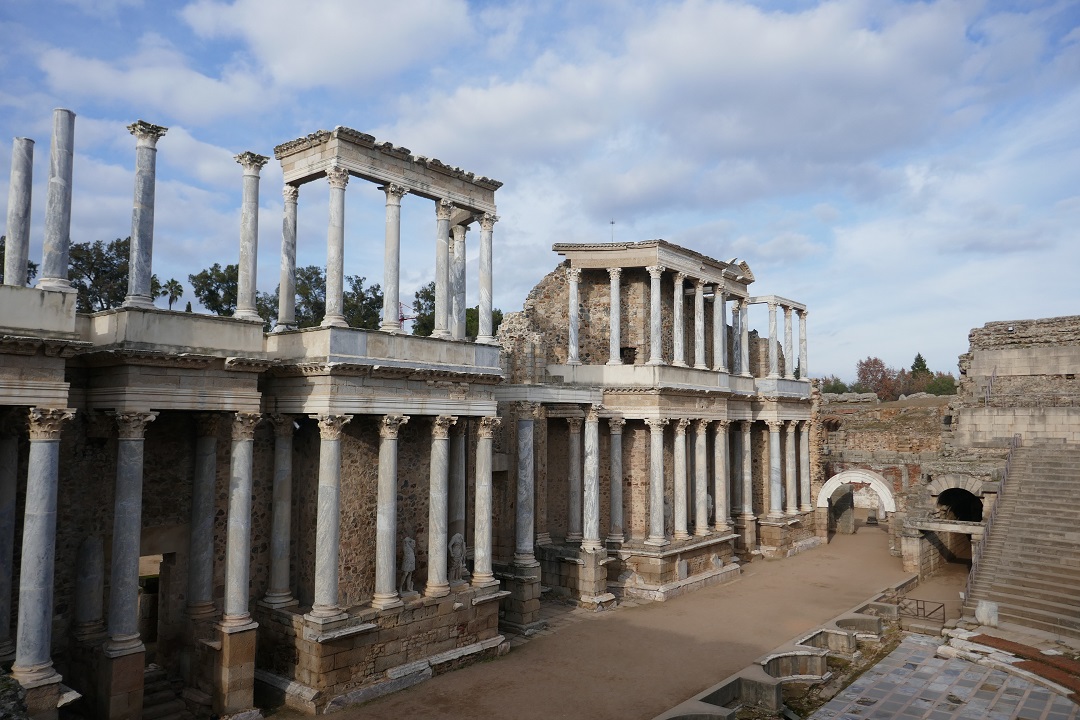
• Access the theatre from the top level (rather than from the openings leading to the stage). This will ensure you have the best first impression on arrival.
• Take your time visiting the Theatre and seeing it from every angle.
• Admire the pretty Corinthian capitals of the columns and the statues of emperors behind them.
• Walk about the gardens behind the Theatre and don’t miss the mosaic in the little house to the west.
Location: Plaza Margarita Xirgú, s/n
Opening times: from 1 October to 31 March, the Teatro Romano opens every day from 9am to 6.30pm; from 1 April to 30 September, it opens every day from 9am to 9pm. Closed on 25 December, 1 January and 6 January.
Anfiteatro Romano
The Amphitheatre is certainly less impressive than the adjoining Theatre, but is as historically relevant. Standing in the arena of this huge elliptical monument makes you appreciate the importance of a place built to host gladiator contests and wild animal fights for the entertainment of over 15,000 people.
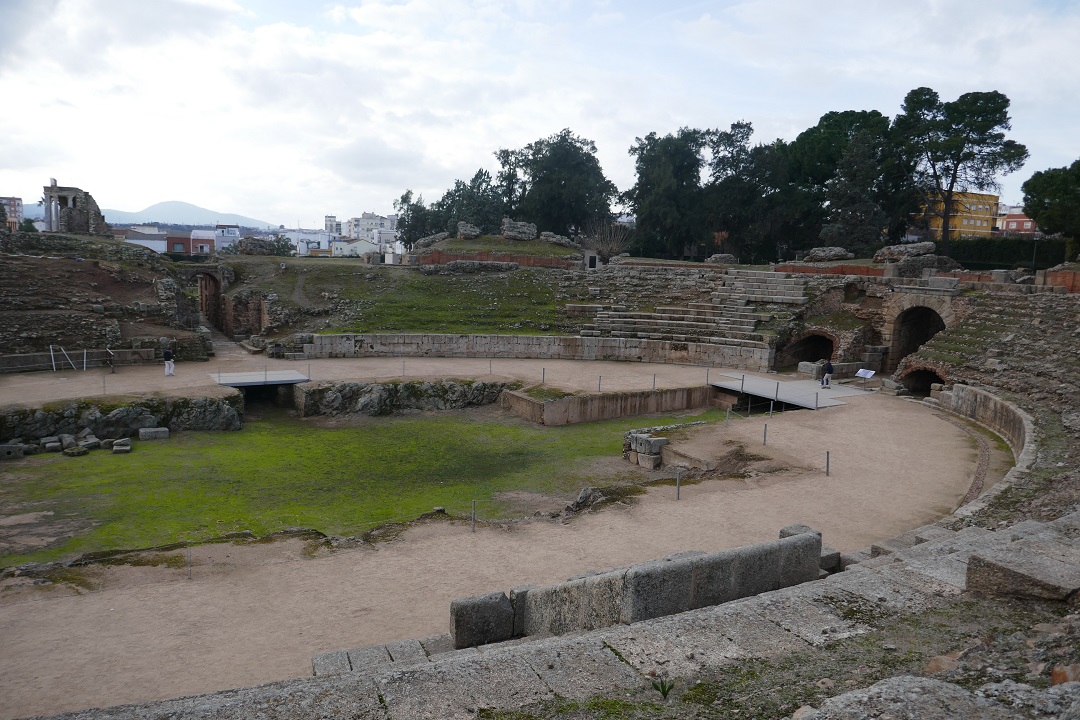
Location: Plaza Margarita Xirgú, s/n
Opening times: from 1 October to 31 March, Anfiteatro Romano opens every day from 9am to 6.30pm; from 1 April to 30 September, it opens every day from 9am to 9pm. Closed on 25 December, 1 January and 6 January.
Casa del Anfiteatro
This large residential complex was a great discovery during my last visit to Mérida (after being closed for several years for renovation works). Located outside the walls of former Emerita Augusta, the Casa del Anfiteatro complex comprises the remains of two Roman houses, part of the city wall, part of the San Lázaro Aqueduct, a decant tower, private baths, and a mausoleum.
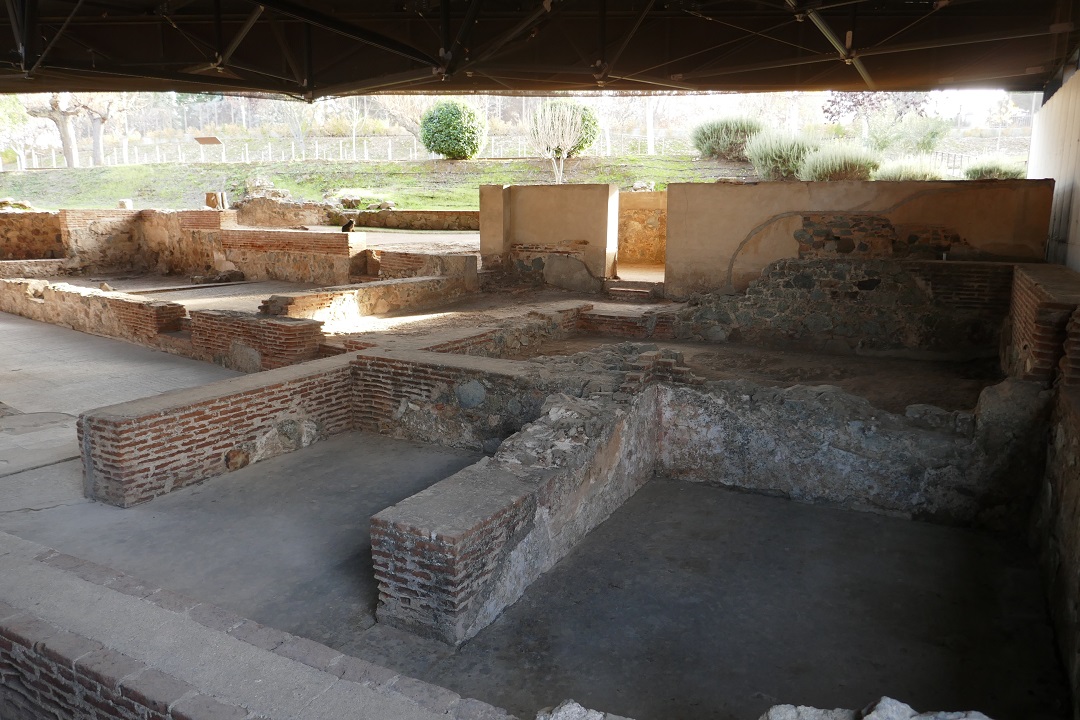
• Appreciate the huge size of the house complex from the central (formerly) porticoed courtyard.
• Pay attention to the floor mosaics, particularly the one depicting grape harvest and grape-treading scenes.
• Notice how close to the aqueduct and private baths local residents live.
Location: Plaza Margarita Xirgú, s/n. Walk past the entrance to the Theatre and Amphitheatre. You’ll find the entrance to the Casa del Anfiteatro on your left.
Opening times: from 1 October to 31 March, Casa del Anfiteatro opens every day from 9am to 6.30pm; from 1 April to 30 September, it opens every day from 9am to 9pm. Closed on 25 December, 1 January and 6 January.
Circo Romano
Built to accommodate up to 30,000 spectators, Circo Romano was one of the most important chariot race venues in all the Roman Empire territory. The Centro de Interpretación offers information about the history of the Circus and about Gaius Appuleius Diocles, a local charioteer who rose to prominence to later race in the Circus Maximus in Rome, becoming what some historians consider the highest-paid athlete of all times.
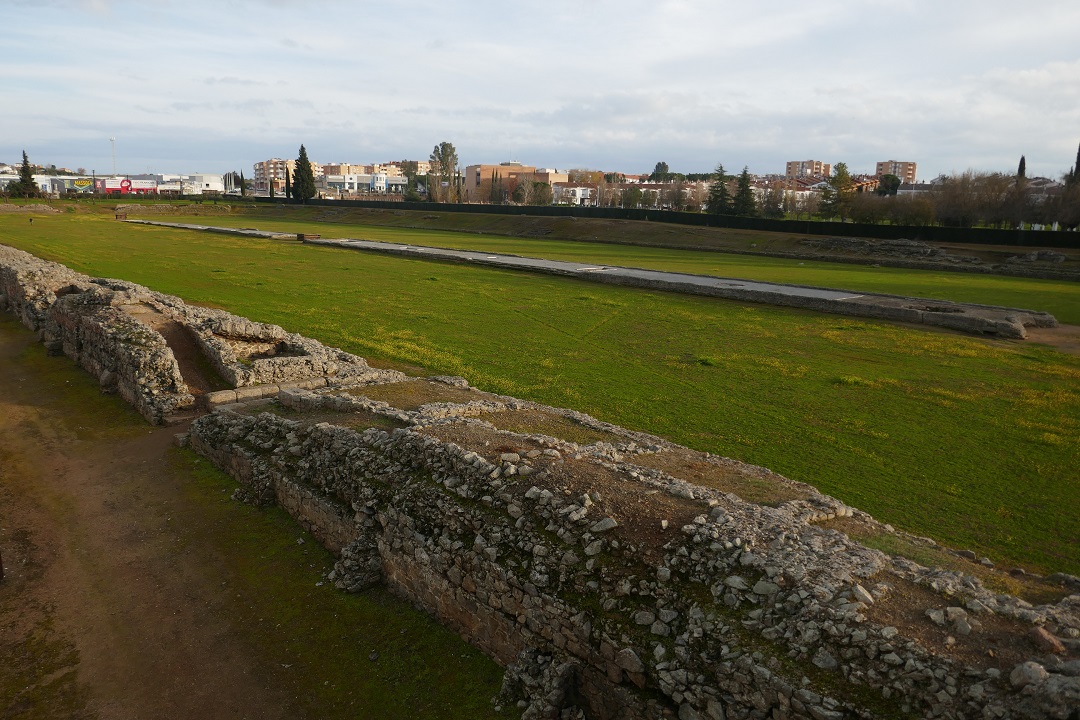
• View the circus from above, by walking out to the little terrace at the Centro de Interpretación.
• Position yourself at the starting gates (the right end, as you walk into the circus) to appreciate how far the median strip is.
• Walk along the median strip to get a sense of the length of the track.
Location: Avenida de Juan Carlos I, s/n. If you’re coming from the city centre, walk on the right-side pavement along Avenida de Extremadura and look out for an underpass near the end of the road.
Opening times: from 1 October to 31 March, Circo Romano opens every day from 9am to 6.30pm; from 1 April to 30 September, it opens every day from 9am to 9pm. Closed on 25 December, 1 January and 6 January.
Casa del Mitreo and Columbarios funeral site
Casa del Mitreo is a former Roman house built outside the walls of Emerita Augusta. The house is organised around three courtyards, its size and the rich decoration of some of its rooms being testament to the owners’ high social status. Steps of staircases leading down to a second lower-ground floor in several parts of the house can still be seen. Casa del Mitreo even had its own private thermal baths, located to the east of the house.
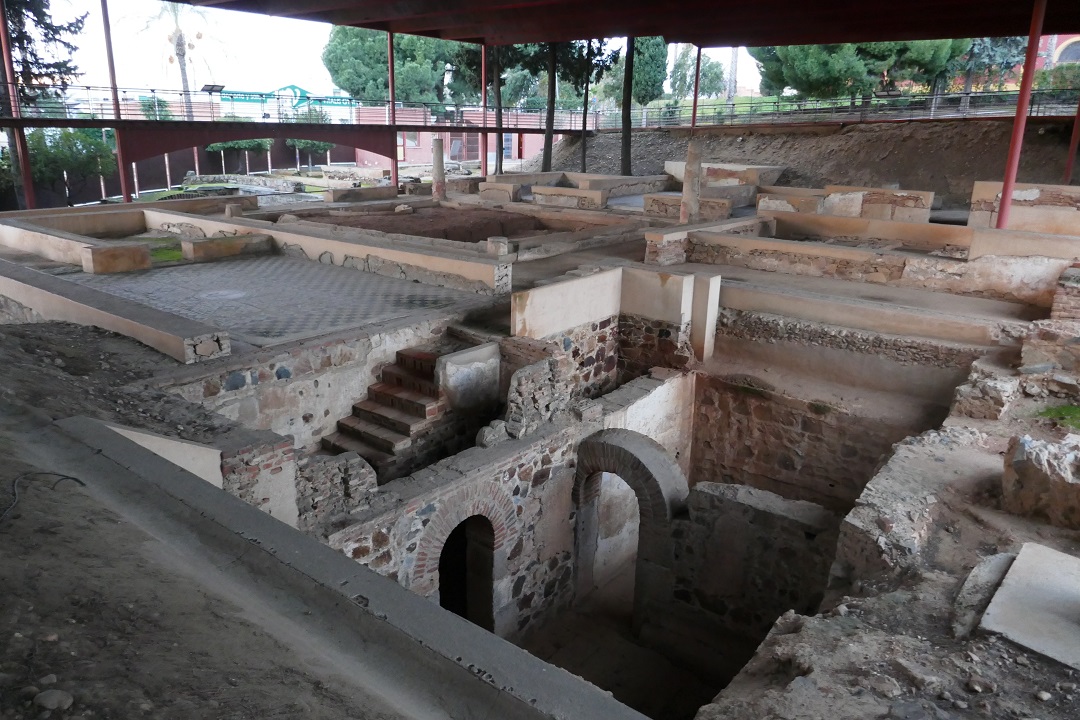
A tree-lined path from the house leads to an area with different types of tombs and the remains of two sunken (formerly barrel vaulted) mausoleums.
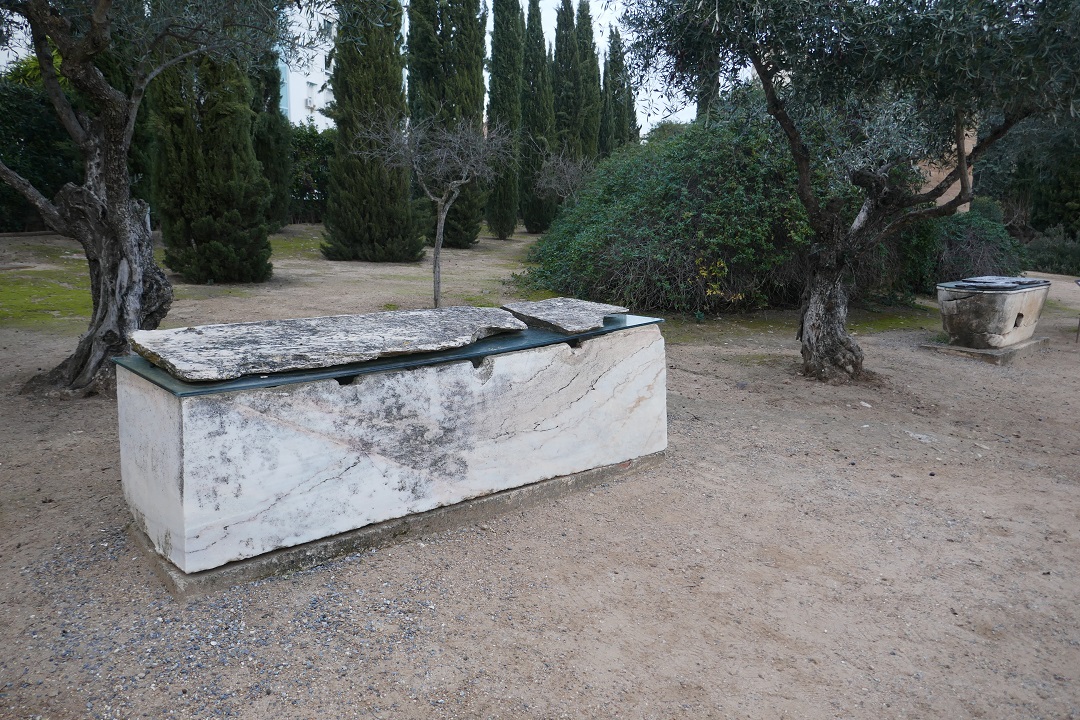
Location: Calle Oviedo, s/n
Opening times: from 1 October to 31 March, the Casa del Mitreo and Columbarios open every day from 9am to 6.30pm; from 1 April to 30 September, it opens every day from 9am to 9pm. Closed on 25 December, 1 January and 6 January.
Templo de Diana
Located in the city centre, this is one of Mérida’s most unusual-looking Roman monuments. It is locally known as ‘Templo of Diana’ but it was, in fact, dedicated to emperor Augustus. Built on a raised pedestal made of locally-sourced granite, it was once surrounded by a colonnade on all its four sides and flanked by two ponds.
At the end of the fifteenth century, a palace was built over the remains of the temple, which explains why it has survived to this date in such a good state of conservation. An interpretation centre inside the palace provides insight into the history and the role of this religious building in former Emerita Augusta.
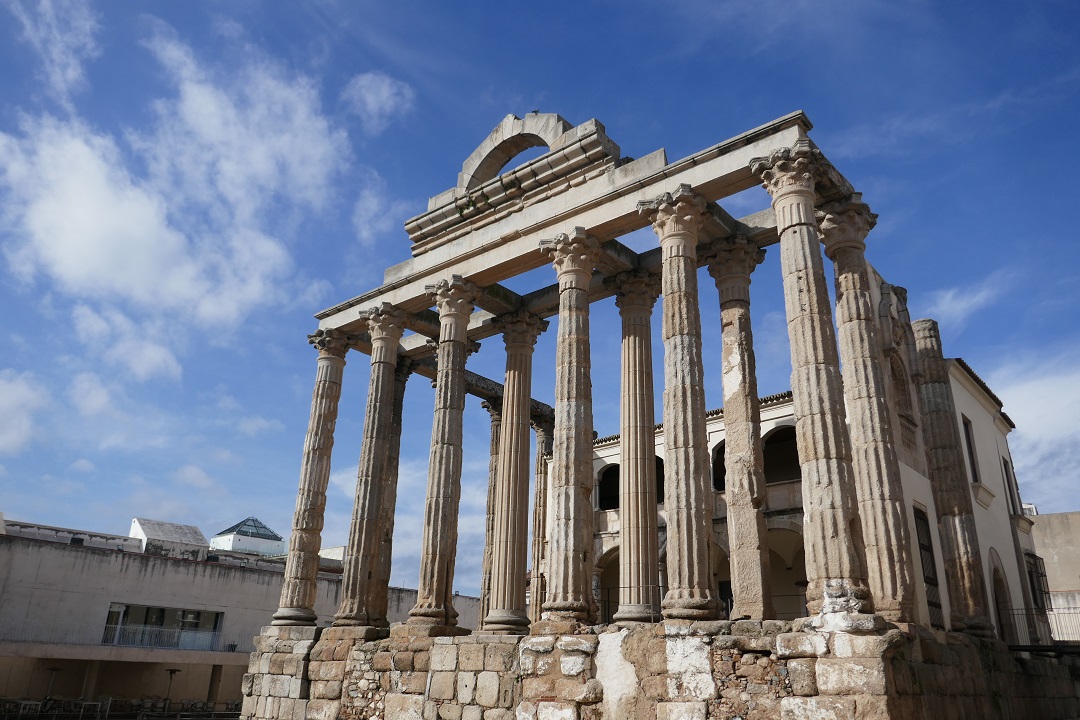
Location: Calle Santa Julia, s/n
Opening times: from 1 October to 31 March, Templo de Diana opens every day from 11am to 2pm, and from 4.30pm to 6:30pm; from 1 April to 30 September, it opens every day from 10am to 9pm. Closed on 25 December, 1 January and 6 January.
Practical info: Entry tickets to the sights 1-6 above can be purchased online and there are several options to visit them. The Roman Theatre and Amphitheatre can be visited with a €13.50 combined ticket. The other sights can be visited separately (at €6.20 each). Alternatively, you can visit all six Roman sights above (and also the Alcazaba, the Morería Archaeological Site, and Santa Eulalia Basilica’s crypt) with a €17.50 Conjunto Monumental combined ticket. Combined tickets allow you to visit the sights on different days.
Puente Romano
At 792 metres long, Mérida’s Puente Romano is the longest surviving bridge from ancient times. It was originally built as a two-section bridge with a large cutwater in the middle, which was partly destroyed by floods. The bridge was pedestrianised in 1991 and today, a ramp in the centre leads down to a park on the river island.
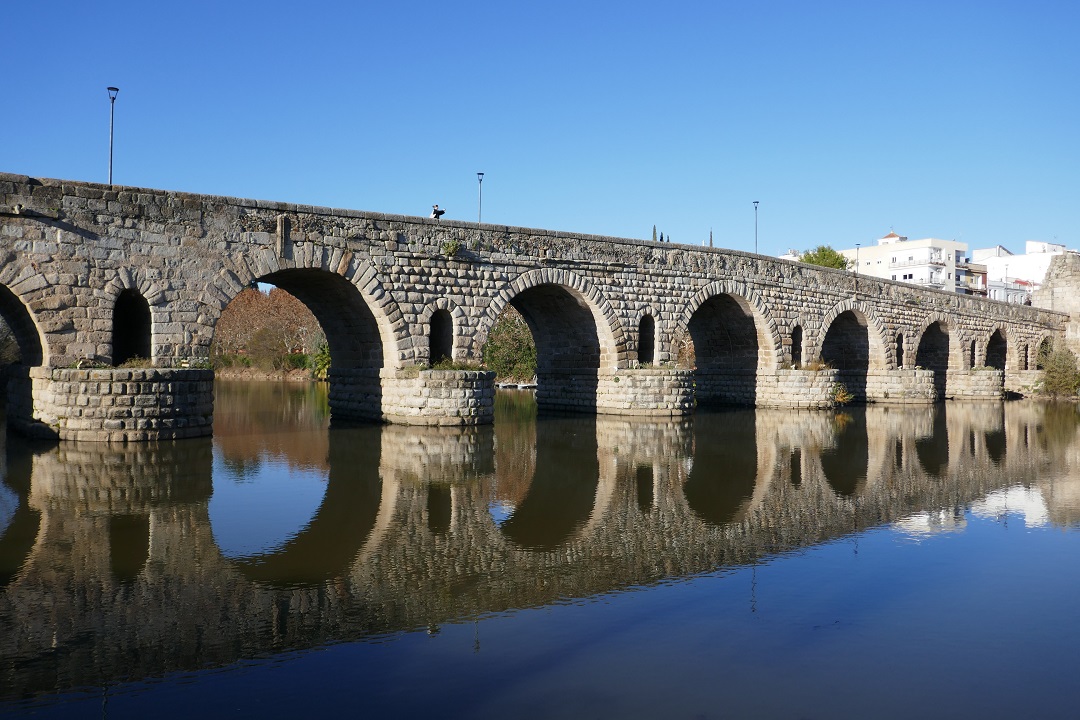
• Enjoy one of the best views of the bridge from the western wall of the nearby Moorish Citadel (Alcazaba).
• Walk to the centre of the contemporary Lusitania Bridge at dusk for a great snap of the Puente Romano when lit up.
• Cross the bridge on foot. If you arrive in Mérida by bus, the 20-minute walk from the bus station to the city centre across the Roman bridge is totally worth it.
Location: Paseo de Roma, 1A
Dique Romano
As you walk into Mérida’s city centre over the Roman bridge, you’ll be able to see the large Roman dyke on your right. On this robust wall with buttresses stands part of the wall of the Moorish Citadel.
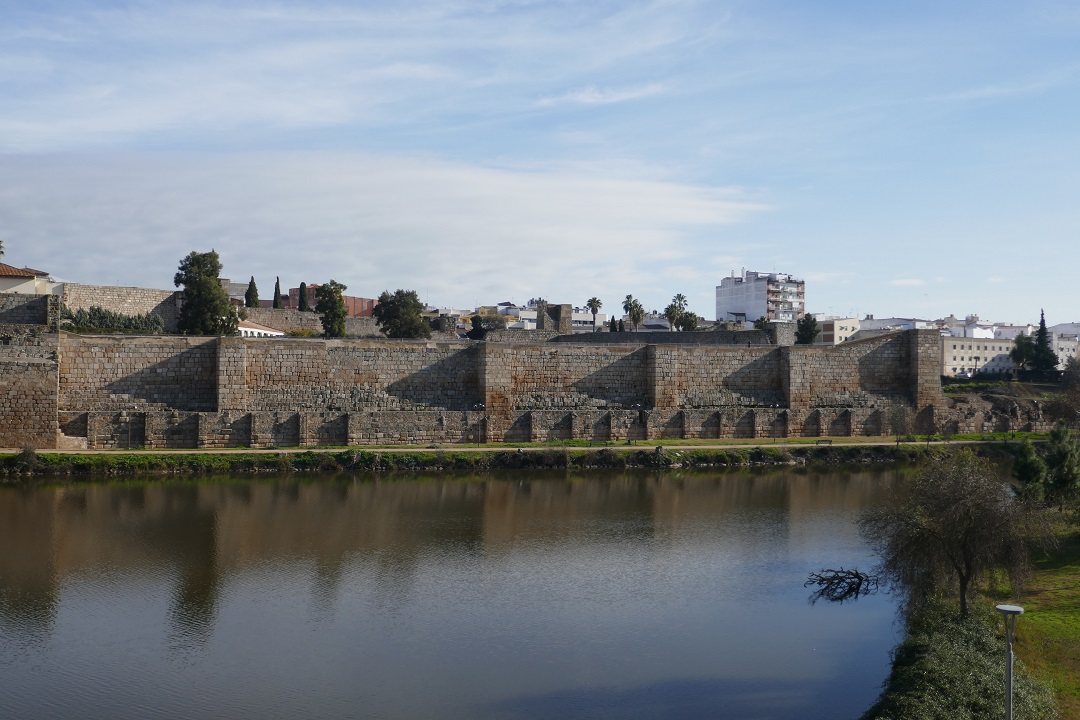
Location: Paseo de Roma, 1A
Museo Nacional de Arte Romano
This stunning contemporary building is a work of art in itself, architecturally speaking, with really high round arches recreating the style of grand late Roman buildings. The museum hosts a fantastic collection of Roman art pieces over three floors, which includes statues, pottery, coins, all kinds of Roman artifacts and some superb mosaics (my personal favourite is the one depicting a wild boar hunting scene called La caza del jabalí). Part of the old Roman road runs through the museum, accessible from the basement.
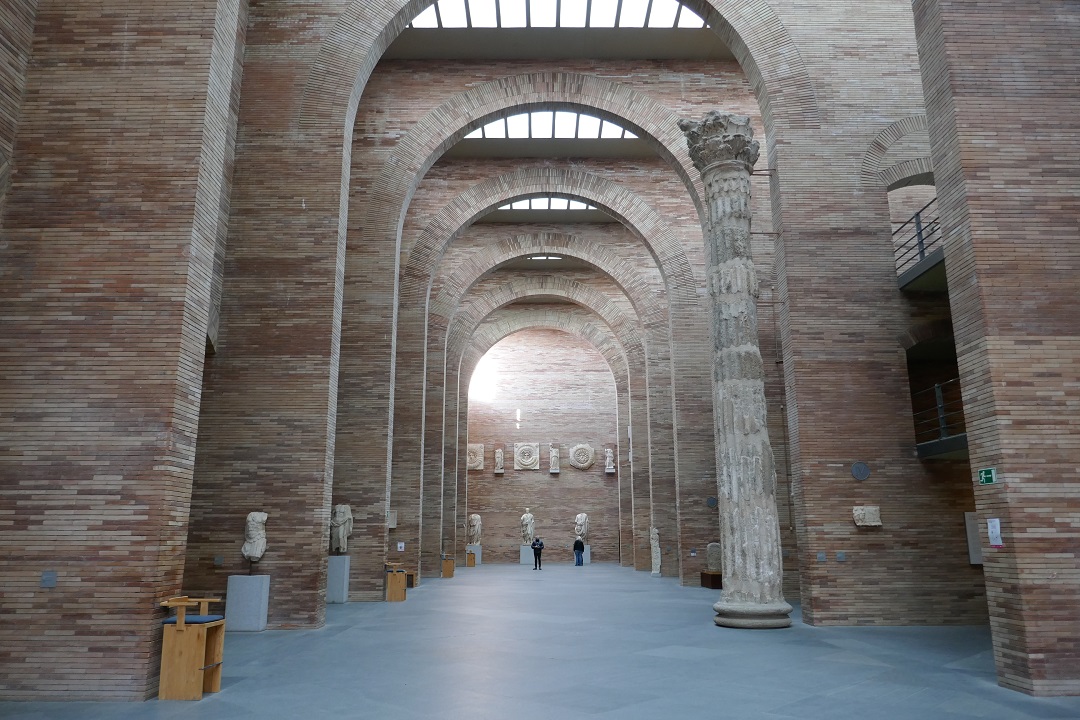
Location: Calle José Ramón Mélida, s/n
Opening times: from 1 October to 31 March, the Museum opens Tuesday-Saturday from 9.30am to 6.30pm and Sundays (and Holidays) from 10am to 3pm; from 1 April to 30 September, the Museum opens Tuesday-Saturday from 9.30am to 8pm and Sundays (and Holidays) from 10am to 3pm. Mondays closed. Tickets to be purchased on site.
Acueducto de San Lázaro-Rabo de Buey
Located very near the Roman Circus, this aqueduct was named after a chapel in honour of Saint Lazarus that was knocked down some seventy years ago. Only some cutwaters, three pillars and a couple of arches of the original Roman Aqueduct remain today. The rest dates back only a few hundred years.
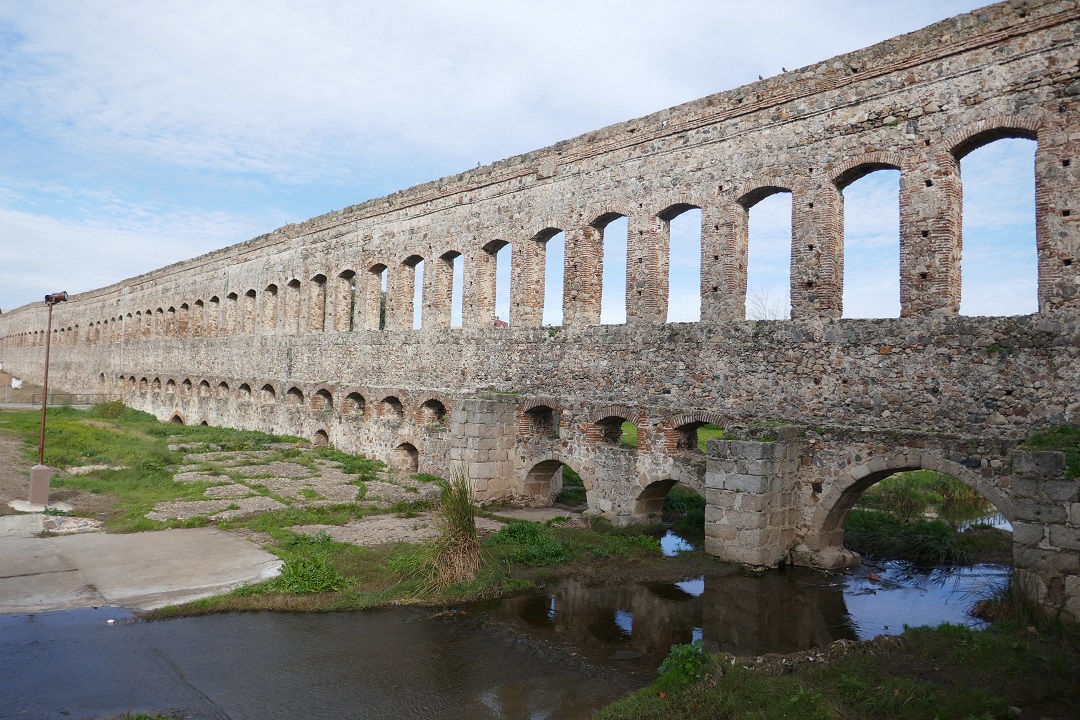
Suggestion: Walk along the aqueduct, cross the road (Avenida Felipe Corchero) and keep following the path up to the Rabo de Buey water tank. It will give you a sense of the length of the aqueduct and offer an interesting view of the city.
Location (approximate): Avenida de Juan Carlos I, s/n, running parallel to Calle Mérida de los Caballeros. If you’re coming from the city centre, walk on the right-side pavement along Avenida de Extremadura and look out for an underpass near the end of the road.
Termas Romanas de San Lázaro
Next to the aqueduct, the Romans built some public baths which, according to the information available, had a steam room, a cold water pool, a hot water pool, a big outdoor pool and an area for playing sports.
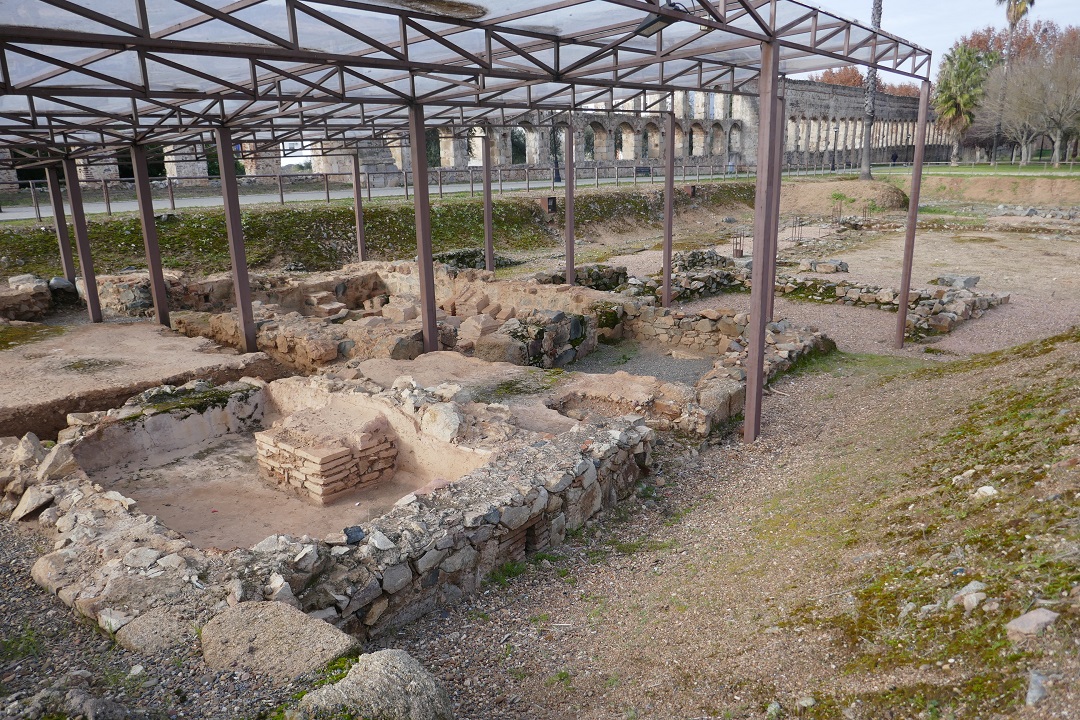
Location (approximate): Avenida de Juan Carlos I with Calle Mérida de los Caballeros
Acueducto de Los Milagros
This is Mérida’s best preserved and more impressive aqueduct. Its arcade over the river Albarregas is one of the city’s most recognisable monuments. Some of its remaining pillars and columns are twenty-seven metres high and are home to a small local colony of storks.
Notice how the Mérida letter sculpture you see before arriving at the Casa del Anfiteatro has been inspired by the Acueducto de Los Milagros.
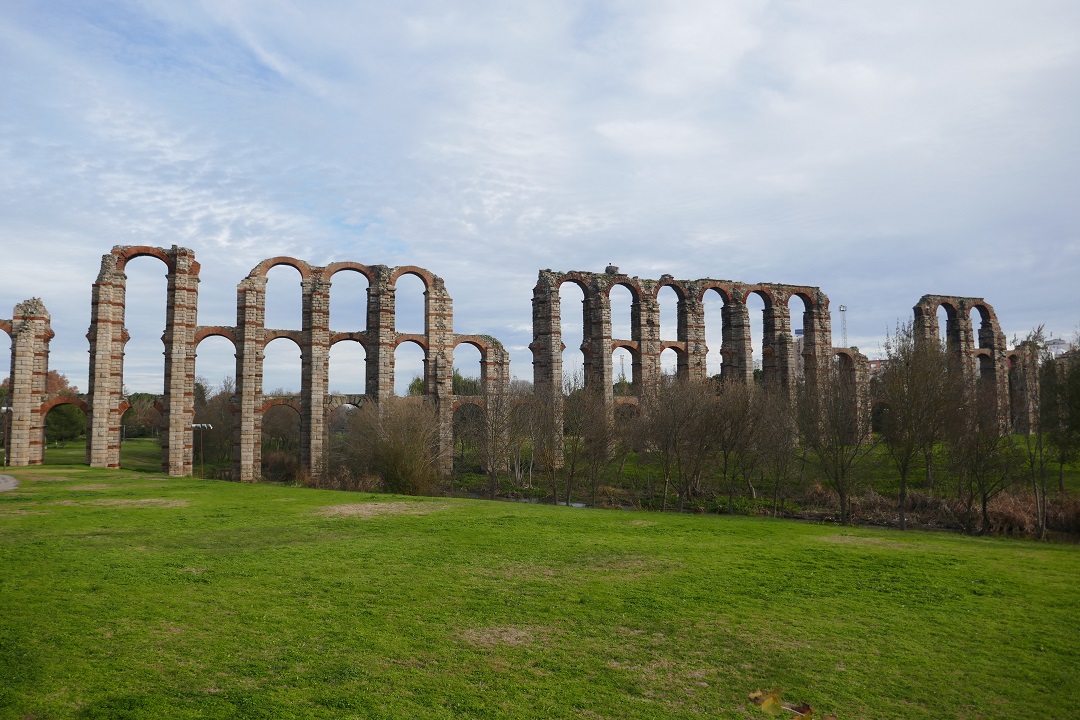
Location: Avenida Vía de la Plata, s/n
Área arqueológica de Morería
Located near the river Guadiana and with a surface of 12,000sqm, this is one of the largest archaeological urban sites in the country. It was discovered in the nineties, when excavation works to build new regional government offices were taking place. Today, the office buildings rise above the site on stilts.
Here you can see numerous remains, including the largest part of the Roman city wall discovered so far, a private house with an opulent black-and-white marble floor, and part of a road. The Vía de la Plata Roman road Interpretation Centre is also located within the site.
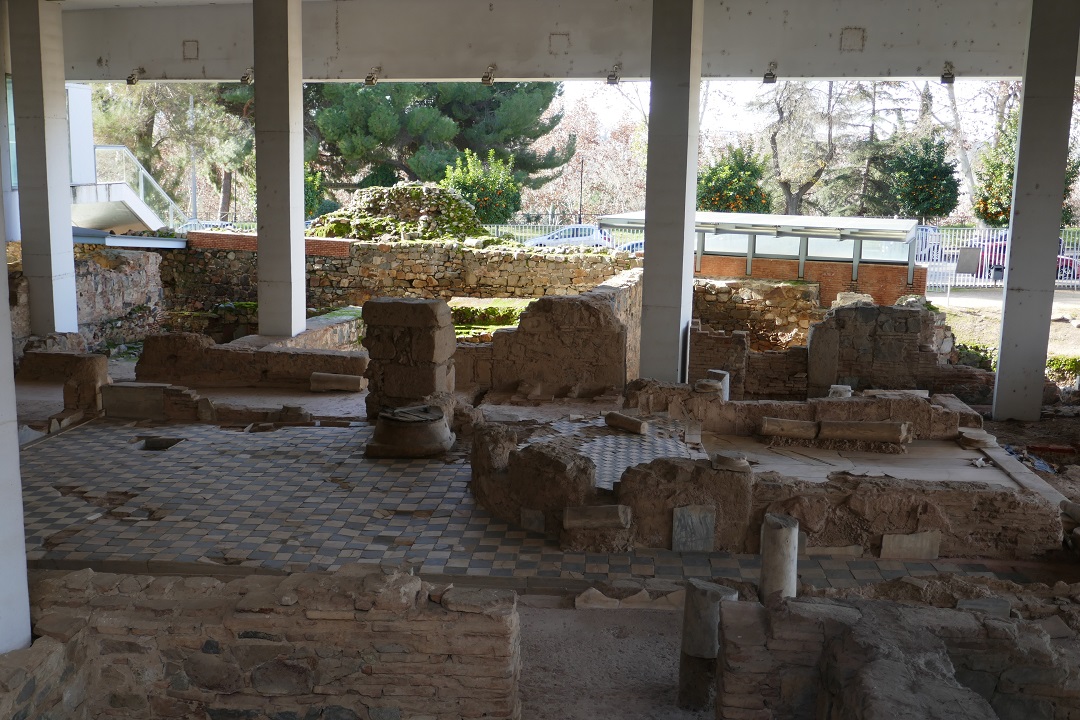
• This is not a Roman-only site. It includes remains from different time periods, such as Moorish palatial spaces and humble houses.
• It is named Morería (‘Moorish quarter’) because in medieval times, the city’s Muslim population was made to live there.
Location: Paseo de Roma, s/n
Opening times: from 1 October to 31 March, Área arqueológica de Morería opens every day from 9am to 3pm; from 1 April to 30 September, it opens every day from 9am to 3pm. Closed on 25 December, 1 January and 6 January.
Arco de Trajano
Despite its name, this 15-metre-high arch had nothing to do with the Roman emperor Trajan. Located on the former main road running across Emerita Augusta from north to south, it’s thought to have given access to a sacred area surrounding a temple. The arch, built in granite, was originally covered with marble slabs.
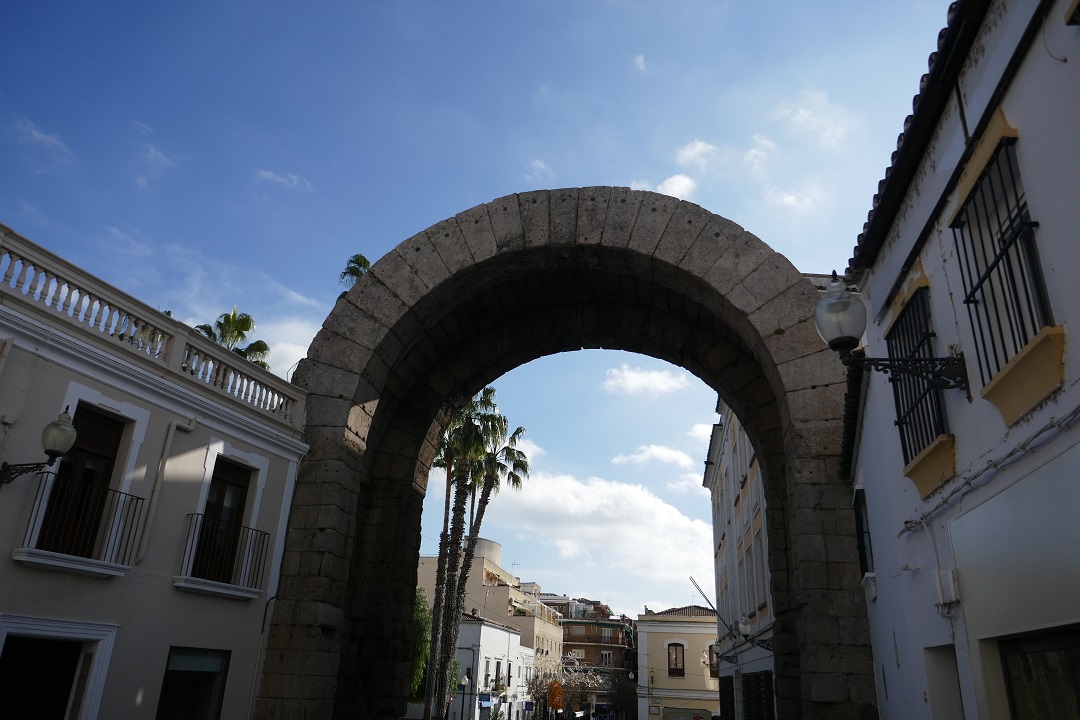
Location: Calle Trajano, 8
Termas Romanas de la Nieve
There are numerous hypotheses about the possible uses of this structure, but, according to the most recent research work, it was a two-floor complex. Several spaces at underground level are believed to have served as a snow and ice house in Roman times, while the ground floor is thought to have served as public baths.
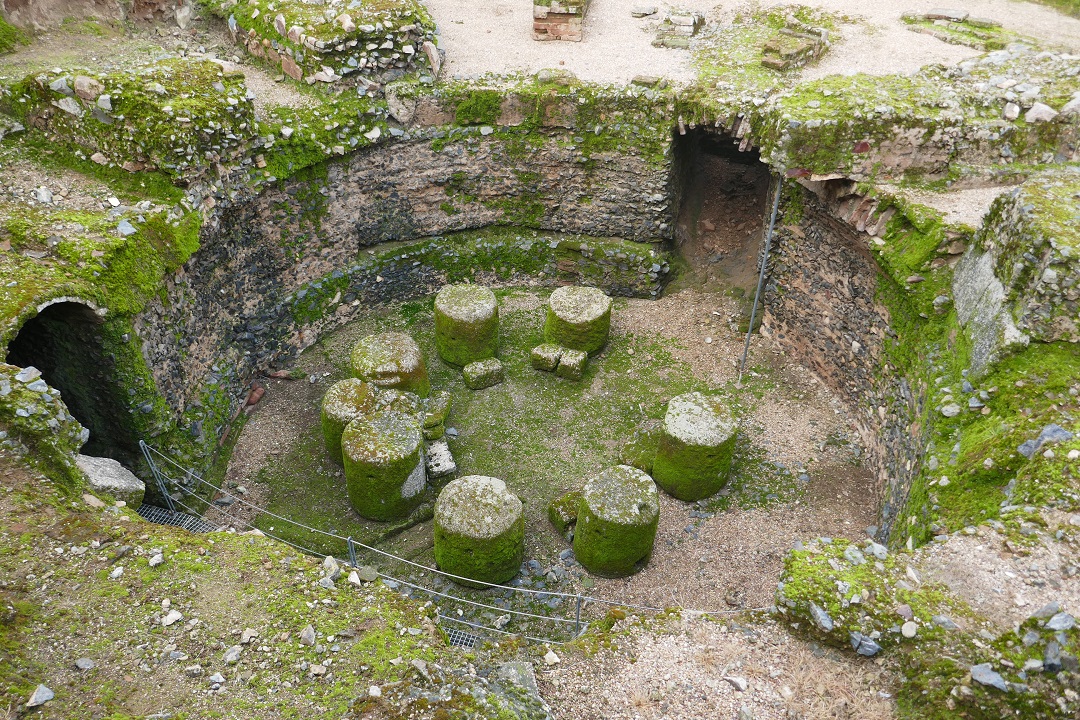
Location: Calle Reyes Huertas, 1
Pórtico del Foro Municipal de Augusto
Not far from the misnamed Templo de Diana are the remains of a columnated portico originally surrounding a huge rectangular forum. Built mirroring the style of the Roman Forum in Rome, the upper part of this portico was decorated with circular medallions depicting Jupiter and Medusa.
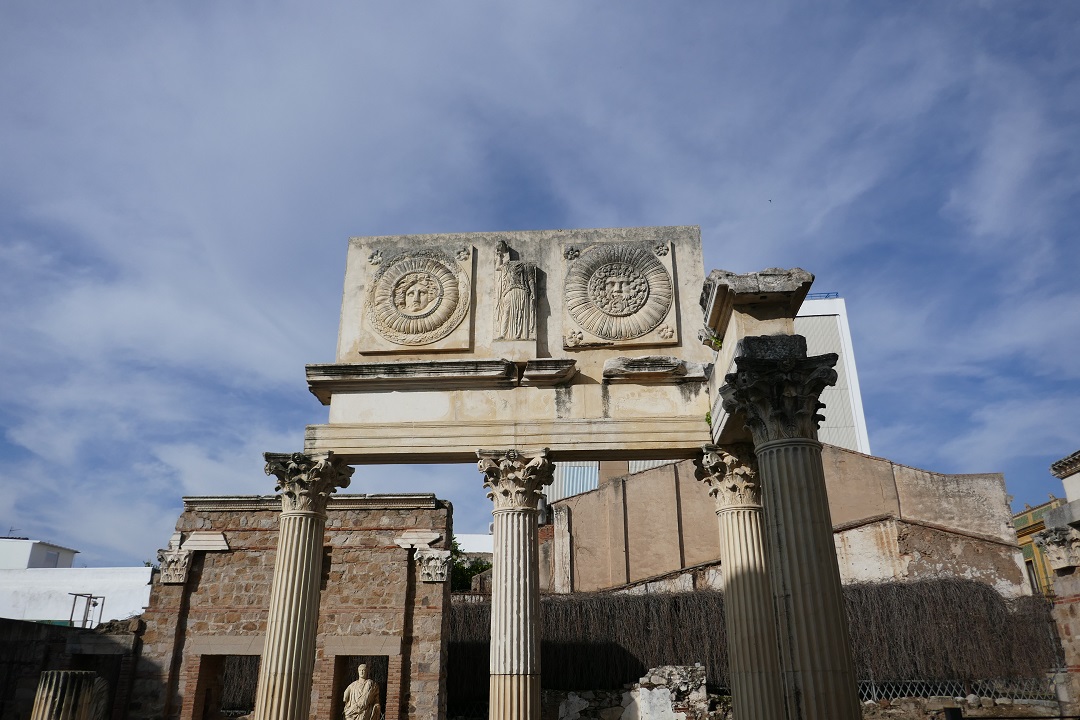
Location: Calle Sagasta, s/n
Termas Romanas
Just over two decades ago, excavation works in a large square plot in the city centre revealed the remains of Mérida’s oldest and best-preserved public Roman baths. The remains surviving to this date include a series of cold, hot, and warm water pools, marble-floored changing rooms, and a large open space for practising sports including a swimming pool.
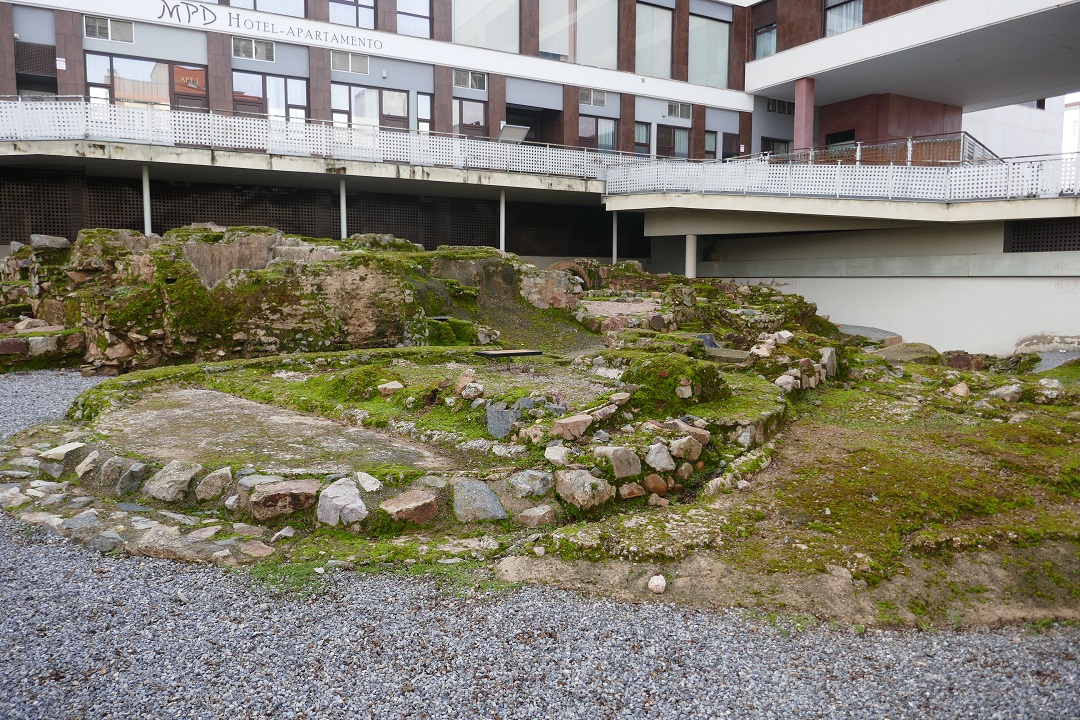
Remember: This is not a Roman-only site. It includes remains from an Islamic burial site, a Visigoth road and a cemetery, and a medieval water piping system.
Location: Calle Pontezuelas, s/n
Torre de Agua (Castellum Aquae)
This sturdy-looking structure are the remains of a Roman monumental water fountain originally attached to a water distribution tower. The front part of the fountain is said to have been covered with marble slabs and included different sculptures.
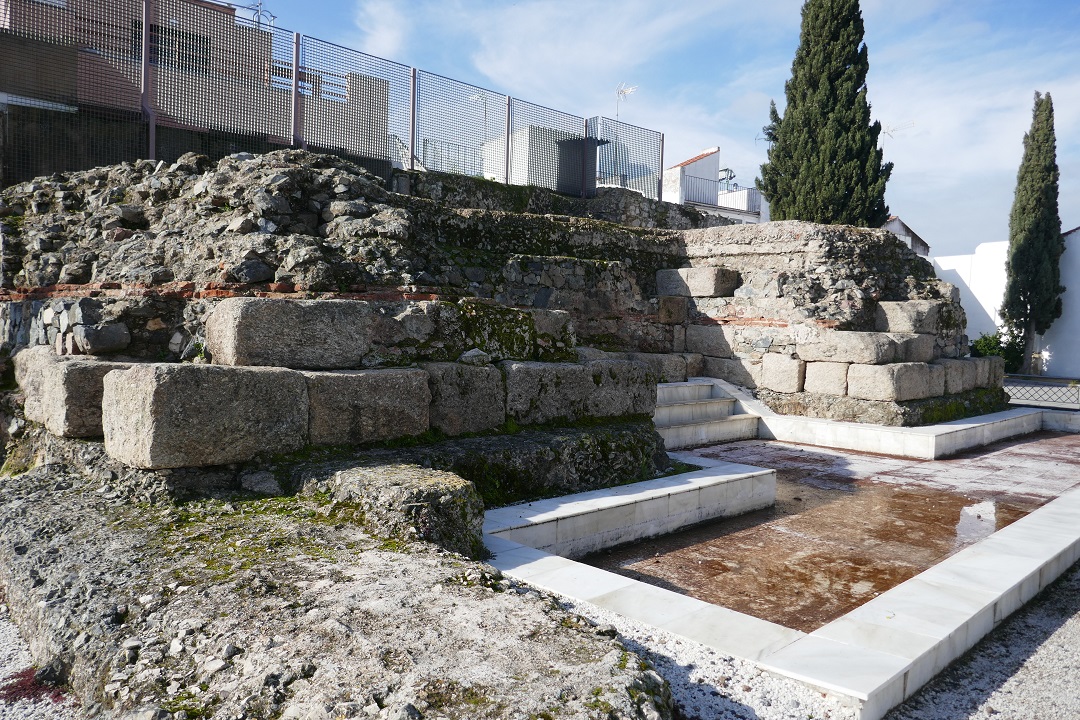
Location: Calle Calvario, s/n
Map of Mérida Roman architecture
Other Roman places you can visit in the Mérida area include the Proserpina Reservoir (5km from Mérida) and the Cornalvo Reservoir Dam (16km from Mérida).
Other articles about Mérida worth a read:
This content is protected by copyright and belongs exclusively to Irene Corchado Resmella. To know exactly what this means, read the 'Copyright' section in the Website terms of use.

Irene Corchado Resmella
Hi! I’m Irene (/ee-REH-neh/). Long since settled in the UK, I explore my Spanish home region of Extremadura with an inquisitive mind, a sharp eye, and the duality that comes with being both a local and a visitor. Then I write about it here to help you discover this beautiful yet overlooked part of Spain. If you have any questions after reading this article, submit a comment below! Read more about me.
